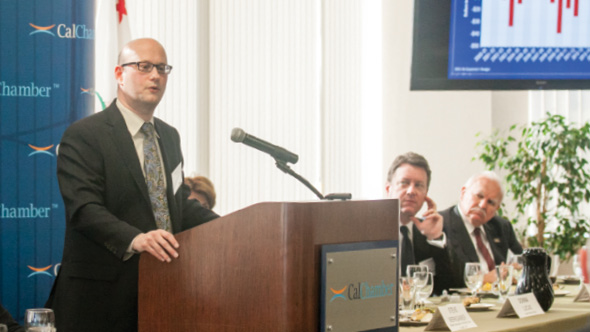Governor Edmund G. Brown Jr. has outlined a “carefully balanced” budget plan for 2015–16, demonstrating his commitment to keep the state on a steady fiscal path.
This week, California Finance Director Michael Cohen presented a detailed analysis of the proposed budget at a California Chamber of Commerce Luncheon Forum.

The same day, a report from the nonpartisan Legislative Analyst’s Office described the Governor’s budget priorities as “generally prudent.”
Highlights of Cohen’s presentation appear in the latest CalChamber Capitol Report video at youtube.com/calchamber.
In his presentation, Cohen discussed budget priorities, including continued investments in key programs, saving money in the rainy day fund and paying down state debts.
“It’s a good budget that’s still in balance… we are continuing to invest in the key programs that we’ve made major decisions on over the last few years, but we are also saving money and paying down our debts,” Cohen told luncheon attendees.
Saving Money/Paying Down Debt
Director Cohen pointed to CalChamber’s efforts as key to securing passage of Proposition 2 last November. The measure amended the State Constitution to strengthen the requirement for a budget reserve and to pay down budget-related debt.
Cohen said the state’s rainy day fund will have a balance of $2.8 billion by the end of the year. Having the fund in place will obviate the need for higher taxes during the next recession.
“The way Proposition 2 works is that if capital gains continue to rise, if the stock market continues to do what it’s been doing the last few months, and that is certainly a possibility, more money will go into the rainy day fund,” Cohen explained.
This means an additional $1.2 billion from Proposition 2 funds will go to paying off loans from special funds and past liabilities from Proposition 98; the remaining $1 billion in deferrals to schools and community colleges will be repaid; and the last payment on the $15 billion in Economic Recovery Bonds borrowed to cover budget deficits from as far back as 2002 will be made. Finally, the money will allow the state to repay local governments $533 million in mandate reimbursements.
The result, says Cohen, is that a year from now, school finance will be back to a place where “when schools spend the money, they will receive the money in the same fiscal year.”
Retiree Health Care
Previous budgets dealt with state pensions and teachers’ retirement. This year’s budget deals with the third piece of the state’s retirement liability—retiree health care costs. “If California does nothing, the unfunded liability will exceed $300 billion by 2047,” Cohen explained.
“That’s really the next major retirement liability the administration is looking to tackle,” Cohen said. “We are going to use everything in our tool kit to both contain health care cost inflation and also start setting aside money so that both employees and the state contribute equally.”
State health care benefits for retired employees remain one of the fastest growing areas of the state budget. In 2001, retiree health benefits made up 0.6% of the General Fund budget ($458 million) but today absorb 1.6% ($1.9 billion). Without action, the state’s unfunded liability will grow to $100 billion by 2020–21 and $300 billion by 2047–48. The budget addresses the need to develop solutions to correct this problem.
Workforce Development
In addition, the budget proposes a major new approach to workforce development. There is $1.2 billion in funding to expand workforce training—supporting a coordinated regional framework for adult education, career technical education, workforce investment and apprenticeships.
“We are really looking to have a coordinated and regionally based system to make sure that our workers get the right training and our schools and educational entities are providing the right training for business and for these areas where job training can actually get people into a job,” Cohen said.
Water
Turning to infrastructure, Cohen discussed funding for water projects. In addition to $533 million from the Proposition 1 water bond to continue implementing the administration’s five-year Water Action Plan for sustainable water management, the budget proposes spending the last $1.1 billion from the 2006 flood bond.
“This is all designed to prepare the state’s water infrastructure for the future and move toward better water sustainability,” Cohen explained.
Transportation
The state’s largest deferred maintenance liability is on the state’s highways, bridges and other transportation infrastructure which totals $59 billion, Cohen pointed out. He reaffirmed the Governor’s commitment to addressing how the state will deal with needed state transportation improvements.
Budget Cycle
In closing, Cohen reflected on the difficulties of the last few budgets and reiterated the Governor’s resolve to avoid the patterns of the past:
“It’s too easy to get back into budget deficits of tens of billions of dollars… what we’ve done over the last few years is really commit to those things we really feel we can continue to commit to for the long term and not over commit so that when the next recession comes, we’ll have some money in our rainy day fund and we won’t have made more ongoing commitments than we should have. We will be better prepared,” Cohen said.
Legislative Analyst
The report from the Legislative Analyst’s Office (LAO) commented that “the Governor’s reluctance to propose significant new program commitments outside of Proposition 98 could help avoid a return to the boom and bust budgeting of the past.”
Over the long run, eliminating the state’s liability for retiree health care would “significantly lower state costs, affording future generations more flexibility in public budgeting,” the LAO report stated.
The LAO repeated the Governor’s caution that current strong revenues “bolstered by a soaring stock market last year, may not continue for long.
“As the Governor argues, the budget remains vulnerable to downturns that may re-emerge with little warning. Building budget reserves and paying down state debts remain important goals.”
Budget Summary
The full summary of the Governor’s budget proposal is available at www.ebudget.ca.gov or www.dof.ca.gov.

